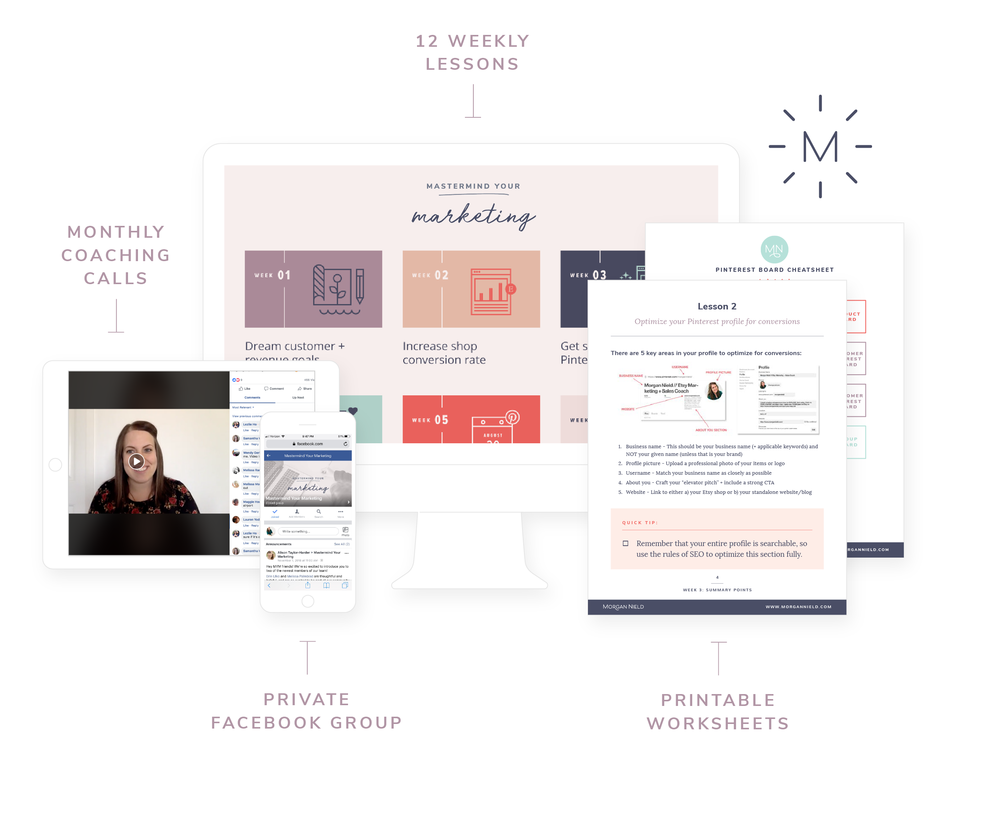Is Your PRODUCT What’s Costing You Sales on Etsy?
We spend A LOT of time talking about marketing here on this blog.
And for good reason-- if you don’t know how to market your product, you’re never going to get found.
However.
One thing we don’t talk about a lot is the fact that sometimes you’re doing #alltherightthings with marketing your Etsy shop…
...but you’re STILL not making sales.
Yep, that can happen, too.
*Sigh*
Luckily, there is a fail-proof way to fix that problem, and it begins with your actual PRODUCT.
Repeat after me: No amount of killer marketing can sell a crappy product line.
Lousy product line = Kiss your dreams of a full-time income buh-bye.
So what constitutes a crappy product line?
I’m glad you asked :) Let’s dive right in!
Big mistake #1
One of the biggest mistakes I see brand-new Etsy shops make is that they create a product for themselves.
What does that mean?
It means that instead of thinking of the customer, they’re thinking of whatever hobby/skill they have and creating product that matches that skill-- WITHOUT thinking about whether someone will be interested in buying it or not.
And that is a sure-fire way to create a shop that FAILS.
Now don’t get in a tizzy-- I KNOW you created your Etsy shop because you genuinely enjoy creating. That’s awesome!
BUT.
You CAN’T go into product creation WITHOUT thinking about your customer-- that’s a completely backwards way of thinking.
If you’re trying to sell to a customer, wouldn’t it make sense to think about them through every step of the way?
You need to be thinking about the customer in the research & development phase, the materials sourcing phase, the product creation phase, the marketing phase…
Basically, you need to be thinking about the customer ALL. THE. TIME.
Ummm...I don’t even have customers, Morgan….
And this is where product validation comes into play ;)
Product validation is simply the way you prove (read: validate) that your product is good enough to sell and that there is a demand in the marketplace for it.
There are TONS of benefits to validating your products, but one of my favorite aspects is that it allows you to “test” your product on an audience before you pour hundreds of dollars into creating inventory that won’t sell.
(Like the time I invested $2,000 in a crib sheet line that completely BOMBED with my audience. Ask me about it sometime ;)
You should be validating your products EVERY. SINGLE. TIME. you introduce a new product line to your shop.
Getting started with product validation
Chances are, if you have been around on Etsy for a while, you have probably already completed the product validation stage.
How do you know if this step is already completed?
You already have an Etsy sales history; or
You do well at in-person events (think: craft fairs) and customers (read: not family members) have purchased your items in the past and been happy with their purchase.
If either one of those scenarios describes your situation, then congratulations-- your product is already validated! You've got the stats to back you up that there is a market for your product-- so I want you to feel confident moving forward.
HOWEVER.
If you’re just getting started and have NO CLUE what actually sells, or if you’re gearing to switch up product lines but are worried about buyer interest levels, it’s probably time to do a little product validation research.
So let's take a look at what it takes to validate a product idea...
Step-by-Step Product Validation
Step #1 - Research the competition
Most of us have been conditioned to believe that competition is a bad thing-- that if someone has already created something, there won’t be any sales left for us.
The opposite is true!
Competition in the marketplace is not only a GOOD thing, it’s actually something you should feel encouraged by.
Why? Because if multiple shops have already created a product like yours, it tells us two things:
There is a market for your product-- hooray!
(note - this brings up the whole “do you mean my state-of-the-art invention has no market?” Of course not, but if you’re introducing something completely new to the table, you had better be willing to do the grassroots legwork to actually EDUCATE people about your product-- because the awareness isn’t there.)
Your marketing just got a heckuva lot easier. You now have prices, materials, marketing strategy, and more to reference when creating your killer product line (note- I said "to reference," NOT "to copy" ;)
So competition? That’s a good sign and it means that there is definitely potential for your product in the marketplace.
Again, if there isn’t any competition, this doesn’t mean your product idea will bomb-- but it does mean you have a lot of work ahead of you to educate your audience on your product + why they need it.
I want you to ask yourself honestly: Are you willing to put in that extra work?
If not, it's time to go back to the drawing board.
Step #2 - Reach out to your dream customer
Once you’ve got that product-line concept (and samples created, if at all possible!), it’s time for the hard part: You need to start talking to people.
And no, I don’t mean your mom and your sister-- I mean people that would be ideal matches for your product. (Fun Fact: I actually pitched my product to my mom before anyone else, and she thought I was crazy and told me to go back to the drawing board. Spoiler alert: I didn’t).
This step is broken down into 2 parts:
2.1 - Reach out to people you already know who match your dream customer profile (read: the person you want to buy your product)
If you're in the baby industry, reach out to friends/family who have recently had a baby or are going to soon.
If you’re in the health and beauty industry, reach out to friends/family who are obsessed with organic products and see what they think.
If you’re in the planner industry, create some prototypes and test them out on your organized friends.
What kind of questions should you ask? Use the following as suggestions (but feel free to substitute in your own!):
What do you like best about this product?
What don’t you like about this product?
Is there room for improvement with this product?
What is the biggest struggle you face with using a product like this?
What would you be willing to pay?
Bottom line?
Ask for feedback on your product(s).
Be willing to take the good (and the bad!) and act on those suggestions (<-- SO important).
This is NOT a time to let personal bias get in the way. While you may think you know what will sell, you’ll never actually know until you ask.
Remember- you’re not creating a product for YOU-- you’re creating it for THEM.
2.2 - Reach out to people you DON’T know, but would be a good fit for your dream customer criteria.
Now that you’ve gotten some good feedback from people you know (and have hopefully made some tweaks based on their feedback), it’s time to pitch your product to an audience of people you don’t know.
Now, if you’ve got an existing fan-base, this is a GREAT time to reach out to them. However, if you’re just getting started, chances are you don’t have a pool of people to pull from.
So where can you find people to get feedback from?
Reddit threads
Facebook groups
Niche blog forums
Again, you're going to want to ask the following questions:
What do you like best about this product?
What don’t you like about this product?
Is there room for improvement with this product?
What is the biggest struggle you face with using a product like this?
What would you be willing to pay?
Yes, I know these are hard questions to ask-- but they NEED to be asked. There is nothing worse than blowing cash on a huge inventory of product that no one will be interested in buying.
Save yourself the headache (and the financial stress!) and do a bit of research before you dive in-- you'll thank me later, I promise ;)
That sounds super overwhelming. I sell 10 different products--how on earth do I get each of those validated without losing my sanity?!
Alright, it’s time to take a step back.
Part of your problem here is that you’re trying (literally) to go 10 different directions at once.
Lack of focus = Major problems.
Because when you’re starting an Etsy shop, you’re trying to wrap your head around a million different things-- photography, copywriting, marketing, etc.
It’s hard enough figuring all of those things out for ONE product, let alone 10.
If you’re trying to market 10 different things to “see which one sells”, you’re going to put out disjointed marketing messaging, and confuse your customers on what you’re trying to sell and what they should buy.
Believe it or not, customers like being told what to do.
They LIKE having limited choices (too many choices = decision fatigue).
So make things easier (and much more clear!) for them and yourself (and your bank account!) by simplifying your product line down to ONE flagship product.
I don’t care that you can make tea cozies and baby blankets and slippers and scarves (well, I do care-- I mean, you sound really talented!). But that doesn’t mean you should.
Did you get that?
Just because you CAN make it, it doesn’t mean that you SHOULD.
I am SO serious about that.
Instead, I want you to pick ONE product to focus on.
(I can already see you asking, “But, but, but how will I know which one to pick? I’m just going to make and list them all to see what sells!”)
No. Just stop right now.
One of the biggest keys to successful marketing (no matter what industry you’re in) is to go ALL IN with ONE thing.
Yes, you can always add additional income streams later with complimentary product lines and such, but right now I need you to focus on ONE and validate that ONE product.
No need to introduce an entire shopping center before you even get started ;)
Alrighty, I’ve followed your steps and validated my product...now what?
Congratulations! You now know that you have a product line that is going to sell...but what’s next?
Your next steps involve listing your product (hooray-- progress!) and then honing in on shop optimization-- make sure it’s an easy “yes” for people to purchase your product!
(If you’re curious on exactly how you can optimize your shop to become a conversion machine, make sure you join the VIP waitlist for my signature program, Mastermind Your Marketing. There are 12 weeks’ (!!!) worth of shop optimization implementation to hold you accountable + make sure that you’re making as many sales as possible with the traffic you drive!)




